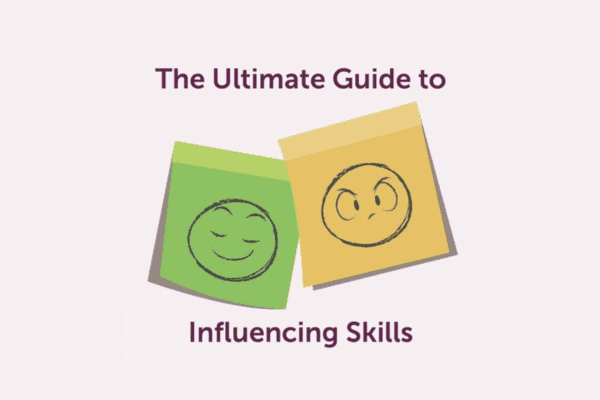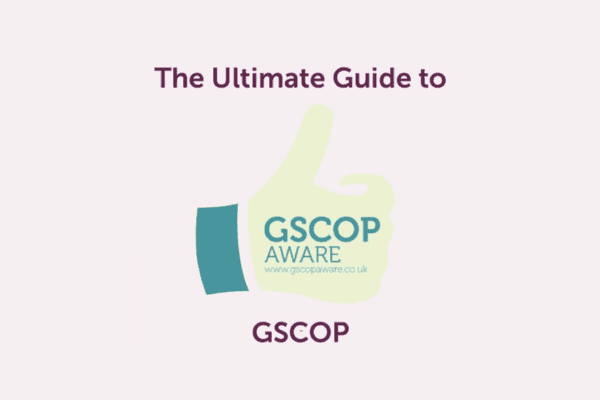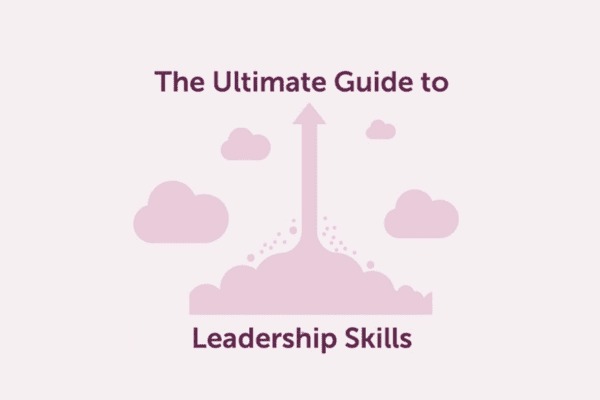What is the HBDI Whole Brain Thinking Model?
Welcome to the Ultimate Guide to the Herrmann Brain Dominance Instrument (HBDI)! Developed by Ned Herrmann, this model offers a unique and insightful approach to understanding how individuals process information, communicate, and make decisions.
At its core, the HBDI model recognises that each person possesses four distinct thinking quadrants. These quadrants represent different cognitive preferences and thinking styles, ranging from analytical and logical thinking to creative and intuitive approaches.
By exploring these quadrants, we can gain valuable insights into our own thinking patterns and those of others. Also, by understanding and embracing our thinking preferences, we can leverage them to optimise our performance and enhance our problem-solving abilities.
In this Ultimate Guide to the Herrmann Brain Dominance Instrument psychometric tool, we will deliver answers and help you to understand the following…
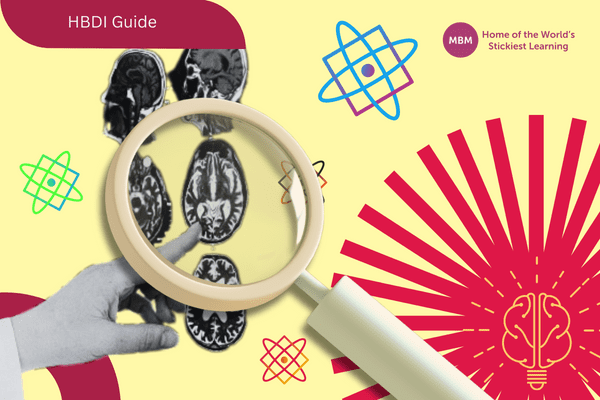
This Ultimate Guide will Cover:
- 1- What is the HBDI Whole Brain Thinking Model? (Above) And What is the HBDI Whole Brain Thinking Assessment?
- 2- Who Founded the HBDI Psychometric Test?
- 3- Is the Herrmann Brain Dominance Test Popular?
- 4- What Can You Expect from Using the HBDI Assessment?
- 5- Example of a Completed Herrmann Brain Dominance Instrument Profile
- 6- Explaining the HBDI Whole Brain Thinking Profile
- 7- Benefits of Knowing Your Herrmann Brain Dominance Instrument Profile
- 8- Can You Increase Your Thinking in Less Preferred Quadrants?
- 9- Can Whole Brain Thinking Support Leadership Development?
- 10- Other Psychometric Tools
- 11- Herrmann Brain Dominance Instrument Profiling vs Other Psychometric Testing Tools
- 12- Further Reading and Resources
1) What is the HBDI Whole Brain Thinking Assessment?
The HBDI Whole Brain Thinking is a psychometric assessment or test, that shows how you prefer to think. Now, we don’t like the words ‘HBDI test’ because it indicates better or worse, so we prefer assessment, as there are no winners/losers or better/worse.
Also, the assessment is often referred to as the ‘Whole Brain Model’ or the HBDI Herrmann Brain Dominance Instrument, and it shows us in which areas we prefer to think, and which areas we prefer not to think.
The Herrmann profile highlights the fact that each of us is different and that we think in different ways. Specifically, it does this by dividing the brain into four quadrants, analytical, practical, relational, and experimental. Each quadrant is represented by different brain dominance profiling colours. All in all, the premise is that each of us prefers to think in one, or a combination of the quadrants.
A conceptual representation of the model is below. By better understanding how we, and others, prefer to think we can improve the way we think, communicate, and make decisions.
By understanding yourself you can learn to understand and value others”.
– Ned Herrmann
There are many psychometric tests. For instance, there is Myers-Briggs, Belbin, or Firo-B. Similarily, each helps us to understand our abilities, motivations, personality, and much more. Specifically, the Herrmann Brain Dominance Instrument helps us to understand how we prefer to think, communicate and make decisions.
What Does Whole Brain Thinking Stand for?
The acronym H.B.D.I. stand for the Herrmann Brain Dominance Instrument. For more on this, download our PDF below by clicking the image.

2) Who Founded the HBDI Psychometric Test?
The creator William ‘Ned’ Herrmann was a physicist by training. He worked for General Electric for over 35 years as a manager. Fascinated by the creative aspects of the brain, he was searching for a way to inspire creativity in the GE employees. From the late 1970s, Ned researched, developed, and validated this dominance model. As a result, Ned is considered by many to be the ‘father of brain dominance technology’ (brain research).
Creativity in its fullest sense includes both generating an idea and manifesting it – making something happen as a result”.
– Ned Herrmann
Sadly Ned died on 24th December 1999. His daughter Ann Herrmann-Nehdi is now the current CEO. You can click on the video below to see our exclusive interview with Ann on the Herrmann Brain Analysis Tool.
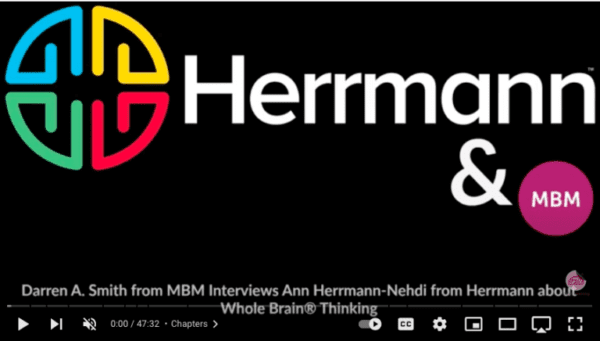
3) Is the HBDI Test Popular?
Over 2 million people have completed their Herrmann Brain Dominance profiles across 45 countries. Also, it has been the subject of 250 dissertations, more than 30 books, and over 100 articles. Even more, it is used by world-class companies. For example, companies such as IBM, Coca-Cola, Kraft, Goldman Sachs, and Target.
Herrmann International does not ‘sell-on’ their product, like many other psychometric tools. Consequently, this means that the team have full access to all profiles ever made. They can, therefore, derive many more insights for practitioners to use.
The Herrmann Brain Analysis test is also CPD accredited and accredited by the Association for Talent Development. And Peter Drucker, the business mastermind, also recommends it in the Harvard Business Press on Knowledge Management.
4) What Can You Expect from Using the Assessment?
The 120-question Herrmann Brain Dominance profile survey results in a profile of your preferred thinking preferences. By understanding your preferences, you can consequently achieve a greater appreciation for how you learn. This, in turn, will help you make better decisions, solve problems, improve communication, and make a lasting impression.
Note the survey measures preferences and not skills. Actually, it is not a test and there are no right or wrong answers. Also, there are no Herrmann Brain Dominance profiling online tests for free. However, if you like to find out more about getting your own Herrmann Brain Dominance Instrument profiling pack, please contact us.
5) Example of a Completed Herrmann Brain Dominance Profile
To illustrate, below is an example of MBM Director and qualified practitioner Andy Palmer’s assessment results:

Undoubtedly, Andy is a Blue, which means that he is keen on facts and details. Under pressure (the dotted line), Andy thinks more about the next steps and planning quadrant (Green). Creative thinking does not come naturally (Yellow) and is not particularly a feelings person (Red). His profile is explained in more detail below:
Which Area of the Brain Do the Colours Represent?
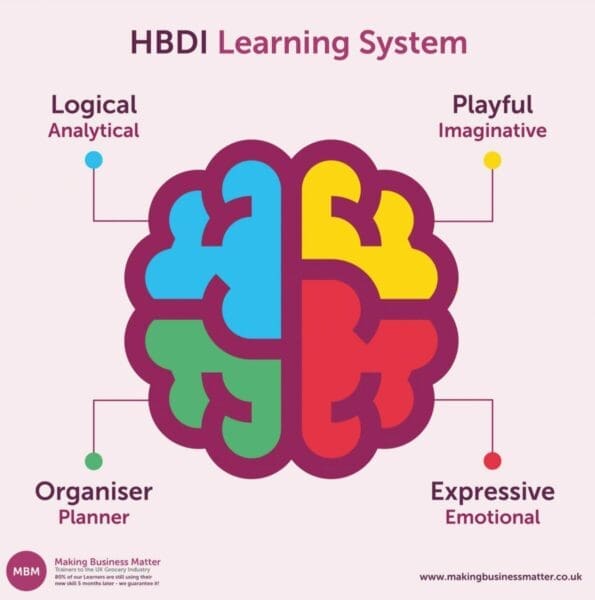
- Blue and green quadrants represent the left side of the brain.
- Yellow and red quadrants represent the right side of the brain.
- Blue and yellow quadrants represent the top half of the brain.
- Green and red quadrants represent the bottom half of the brain.
What are the 4 Quadrants of the Brain?
- A – Blue quadrant: Logical, technical, and financial. In a single word ‘Fact’, or as a profession – Engineer.
- B – Green quadrant: Organised, detailed, and structured. In a single word ‘Form’, or as a profession – Project Manager.
- C – Red quadrant: Emotional, sensory, and people. In a single word ‘Feeling’, or as a profession – Teacher/Nurse.
- D – Yellow quadrant: Risk taker, intuitive, and the big picture. In a single word ‘Future’, or as a profession – Entrepreneur.
A word of caution: We need to be careful not to ‘pigeon hole’ a person to a single colour. Everyone uses all the colours. So this is about our preferences.
Excuse the Interruption, but Here’s a Little Bit About Us…
We are the soft skills training provider, partnering with clients that are frustrated by people returning from training courses and then doing nothing differently. Our clients choose us because we achieve behavioural change through our unique training method, sticky learning ®.

6) Explaining the Whole Brain Thinking Profile:
What Do the HBDI Colours Represent?
Quadrant A is about facts and ‘computing’, and so ‘Cerulean Blue’ was chosen. The following quadrant, Quadrant B is about organisation and structure, and so green was chosen to represent ‘groundedness’. Quadrant C is about feeling and emotion, so red was chosen. Finally, Quadrant D is about imagination so yellow was chosen for its vibrancy.
Our own personal take is that the relationship of the colours to the quadrant characteristics is a little tenuous. This is because blue will not be seen by everyone as a ‘computing’ colour. The very useful part is that the colours enable our clients and Learners to talk to each other in the third person. For example, by saying, ‘Oh, I now understand why you ask those questions, because you are a blue, and you need to know the detail’.
What Do the Numbers Mean?
On every Herrmann Brain Dominance Instrument profile, there are 3 sets of numbers. These numbered represent Preference Code, Adjective Pairs, and Profile Scores.

#1- Preference Codet:
This consists of four numbers placed in order of the quadrants: ABCD. The terms ‘Strong Preference’, ‘General Preference’, and ‘Low Preference’ are used to label the 1, 2, and 3 zones of the profile grid.
These correspond to the Profile Scores:
- 1 corresponds to a strong preference (above 66).
- 2 corresponds to general preference (33 – 66).
- and 3 is a negative preference – that is, avoidance (0-33).
For instance, Andy has an ‘1122’ profile which means that he has a strong preference for thinking in Blue and Green, and a general preference for thinking in Red and Yellow. He does not have any 3 scores which would be quadrants he has a low preference for.
#2- Adjective Pairs:
In the Herrmann Brain Dominance questionnaire, you are asked to choose between 12 pairs of adjectives designed to see how you prefer to think under pressure. There are a total of 24 points distributed across the 4 quadrants. This gives the dotted line preference showing our profile under pressure, also known as your ‘backup style’.
For Andy, this means that when he is under pressure he chooses to think more in the Green quadrant, which is about planning. For example, consider someone who when the ‘chips are down’ might respond with: ‘Firstly, let’s get a meeting, secondly, let’s decide on ABC, and thirdly, we’ll organise the XYZ’.
#3- Profile Scores:
The scores range from 8 to 189. They show how much you prefer to think in that quadrant when not under pressure.
The numbers simply show how far your profile ‘reaches’. The further your outline reaches the outer circles, the more you prefer to think in that way. Remember, you can think in all 4 quadrants. However, you just prefer to retain your thoughts in some, rather than others. Andy prefers to think in facts (Blue 108), which means that he can be known to want 3 decimal places!
What’s the Function of the Dotted Line?
The dotted line shows how Andy prefers to think under pressure, or when he is stressed. In his case, he becomes more organised because the dotted line extends from reaching just the first circle to almost reaching the outer circle. This manifests itself, for instance, as needing to list all the tasks that he needs to do and organise them into a plan.
Not everyone’s profile changes under pressure. The Herrmann team suggest that, as a result of the demands on the average knowledge worker, our stress profile (dotted line) is probably how we prefer to think at work all the time.
What Do the Percentages Mean?
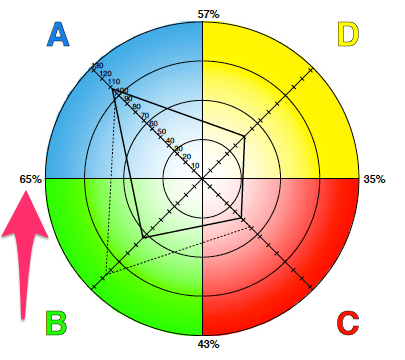
The percentages show how much Andy thinks in the top versus bottom half of his brain, and how much he prefers to think in the left versus the right-hand side of his brain.
Is there an Ideal Herrmann Brain Profile?
The short answer is no. The long answer is that whilst you could think that being dominant in all four quadrants would be an advantage, the disadvantage might be that the person takes a long time to come to a decision. The important part to keep in mind is Whole Brain Thinking, and we can all use all of our brains.
How Do the Different HBDI Quadrants Interact with Each Other?
As a rule of thumb the diametrically opposed Herrmann Brain Dominance quadrants, e.g. blue & red, and yellow & green, will find it most challenging to get along. It can, unfortunately, be human nature to dismiss what we don’t understand.
For instance, hearing a fellow colleague that ‘needs a plan’ (as a yellow), can be dismissed as someone who is ‘anal about detail’. Or, likewise, the green that sees a friend talking about wild ideas and thinks that ‘he just has his head in the clouds’.
The challenge is to appreciate the strengths of others and work together as a team. In other words, yellows have an idea, the blues confirm the numbers, the greens create the plan, and the reds buy people into the journey.
7) Benefits of Knowing Your Herrmann Brain Profile
By understanding yourself better you could ‘play to your strengths’, thus using your time to do more of the activities that are in your quadrant. Additionally, ‘use’ the people around you for the quadrants where you are not as dominant to build ‘cognitively diverse’ teams. As a result of better understanding others, you can communicate in ‘their language’, give feedback how they need to hear it and understand the weaknesses in your team. This was just to name only a few of the applications.
To measure how well you use your understanding of the Herrmann Brain Dominance Instrument you can use our competency framework. This will help you to understand how a person uses this psychometric test on basic and on more advanced levels.
What is Cognitive Diversity? Why Is it Important?
By having a better understanding of the differences in the ways that people process and make sense of the world, organisations can harness the benefits. Take a look at the PDF image below to learn more:
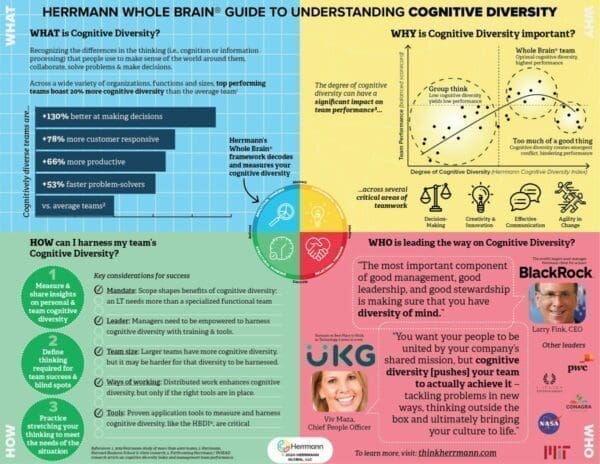
Can You Give Specific Examples to Help Me Understand Further?
- Consider, for example, that partners are buying a house. The woman is dominant in the red quadrant and the man is dominant in the blue quadrant. He likes a particular house because it is only 4.7 miles from the train station. She prefers a particular (other) house because it ‘feels right’. Both quadrant thoughts are ‘right’. The challenge is to appreciate each other’s perspectives and celebrate that they are different. The trick is to then find common ground, e.g. they both think in yellow and therefore they make a decision more by focussing on their yellow thinking.
- When learning time management, a Blue Learner may be more interested in the technique of putting time on each task on their daily list because they can analyse how they spent their time.
- When learning Negotiation Skills, a Green Learner may be more interested in the 7 stages of negotiation because they can see how the negotiation will progress through the stages.
Present More Effectively by Appealing to All 4 Quadrants
During Herrmann ® training, a Learner asked one of our trainers, ‘How can I use the test to help me present better?’ To illustrate, the trainer drew this flip chart:
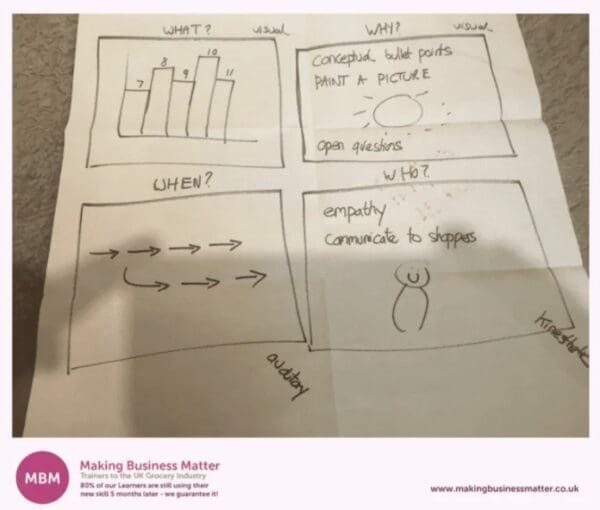
The flip chart shows the 4 quadrants of the Herrmann Brain Dominance Instrument model. Each square on the flip chart shows how a slide could be presented to communicate more effectively to all 4 quadrants. Furthermore, it also addressed the 4 main questions asked by each quadrant; the Blues ask ‘What?’, the Yellows ask ‘Why?’, the Greens ask ‘When?’, and the Reds ask ‘Who?’
If you are unsure of the profile of your audience we suggest appealing to all 4 quadrants. This can be tested by ensuring that there is a specific slide that will appeal to each colour. You can then see how your audience reacts. Lastly, if the audience proves to be dominant in one colour, then your presentation should lean towards this style of communication. This will allow your presentation to have the maximum influence and impact.
Improve Your Decision-making Approach
We all make hundreds of decisions each day. Many of the decisions we make have an impact on other people, and more often than not without having the time to really think about them fully. Using the Whole Brain Thinking theory of decision-making, we can help leverage our own preferences, and our not-so-preferred preferences, to make faster and better choices.
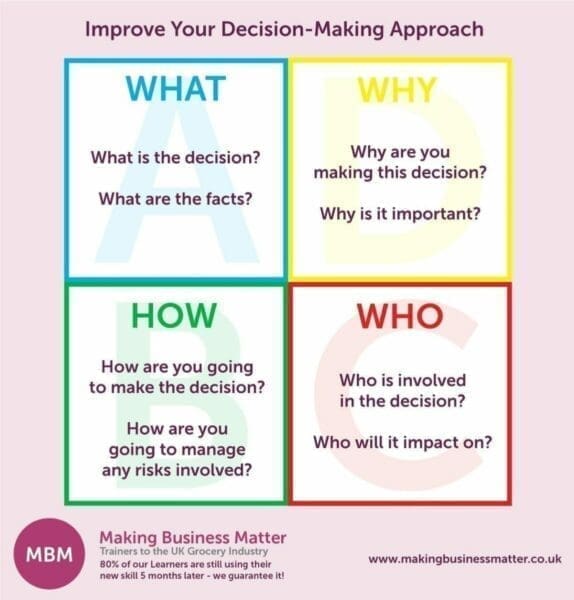
Improve Your Problem-Solving Ability With The Herrmann Brain Dominance Instrument
Problem-solving by brainstorming underpinned with the Herrmann Brain Dominance profile is undoubtedly more powerful. Brainstorming is a creative technique by which efforts are made to find a conclusion for a specific problem. It is usually done as a group with ideas and solutions spontaneously created. To illustrate, here are 4 different ways to brainstorm, each using a different quadrant of the brain encouraging whole-brain thinking.
- Maths-storming – the blue quadrant.
- Similar-storming – the green quadrant.
- People-storming- the red quadrant.
- Super-storming – the yellow quadrant.
It is important not to exclusively select the technique from your highest degree of preference. For example, as a Blue, I may find the blue technique most comfortable. Yet, the yellow could yield better ideas and different results.
Click the image below for a higher resolution.
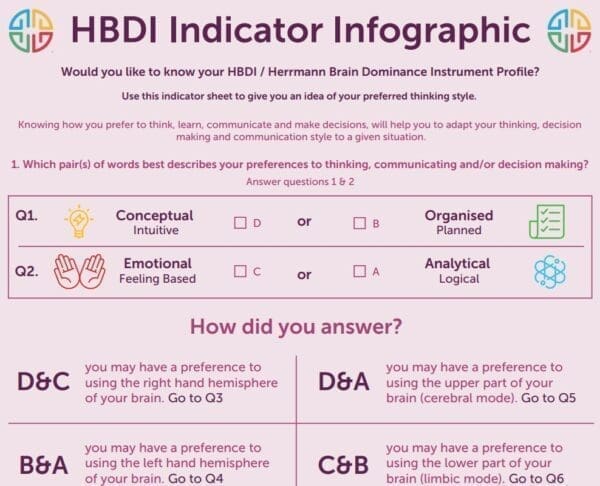
There is no HBDI test or assessment free online. However, you can use the above matrix and these sample questions, working around the quadrants to develop a better understanding of perspectives and considerations.
8) Can You Increase Your Thinking in Less Preferred Quadrants?
You can stimulate the other quadrants of your profile and apply a transformative thinking approach by doing activities in that quadrant. To illustrate, here are some examples of activities that can help you develop your thinking ability and thrive:
#1- Blue Quadrant:
- Take a current problem situation and analyse it into its main parts.
- Convert your retirement dreams into a quantitative map from now to then.
- Write a critical review of your favourite movie.
#2- Green Quadrant:
- Assemble a model kit with the instructions.
- Develop a personal budget.
- Organise your picture files.
#3- Red Quadrant:
- Play with your children the way they want to play.
- ‘Dance’ without moving your feet.
- Take a 10-minute ‘feeling break’ every morning, afternoon, and evening.
#4- Yellow Quadrant:
- Invent a ‘gourmet’ dish and actually prepare it.
- Allow yourself to daydream.
- Imagine yourself in the year 2025.
9) Can HBDI Whole Brain Thinking Support Leadership Development?
By understanding your people better you can communicate more ‘in their language’. Furthermore, you can understand that a leader can be dominant in any quadrant. However, the challenge is working on those less dominant quadrants, and using the strengths of the people in your team to be ‘a whole brain’.
..whole brained teams are 66% more effective than homogeneous teams”.
– Inclusive Leadership Playbook.
Herrmann International has written an excellent whitepaper called ‘Inclusive Leadership Playbook‘: This explains how leaders should embrace diversity and found that ‘whole brained teams’ are substantially more effective.
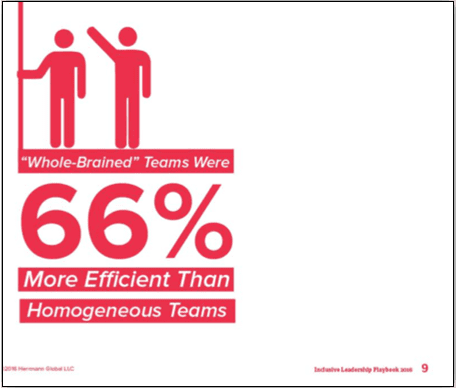
That’s 16% per cent greater than half!
How Much Does the Certification Training Cost?
HBDI Certification Training is typically a three-day workshop to become accredited, you’ll learn to use, apply, and interpret the HBDI® and utilise Whole Brain® Thinking approaches.
10) Other Psychometric Tools
Thinking and powerful assessment tools, such as psychometrics, can help to find a person’s ‘fit’ within a business by evaluating their skills, knowledge and personality. Consequently, they are often heavily used for recruitment, but can also provide useful data as a management tool for team building, development and leadership success. Furthermore, they can help the person develop an awareness of their own strengths and weaknesses.
There are a variety of psychometric tests available. Some focus on measuring a particular skill or aptitude, whilst others look to create a profile of specific traits.
Here is an overview of some of the most widely used psychometric tests:
#1- The Myers-Briggs Type Indicator
This analyses an individual’s personality traits, classifying them according to Carl Jung’s theory of psychological types: extraversion/introversion, sensing/intuition, thinking/feeling, (and adding a fourth) judging/perceiving.
For a quick way to discover your MBTI profile, click on the PDF below. To find out more see our Myers Briggs Ultimate Guide.
Click the image below for a higher resolution.
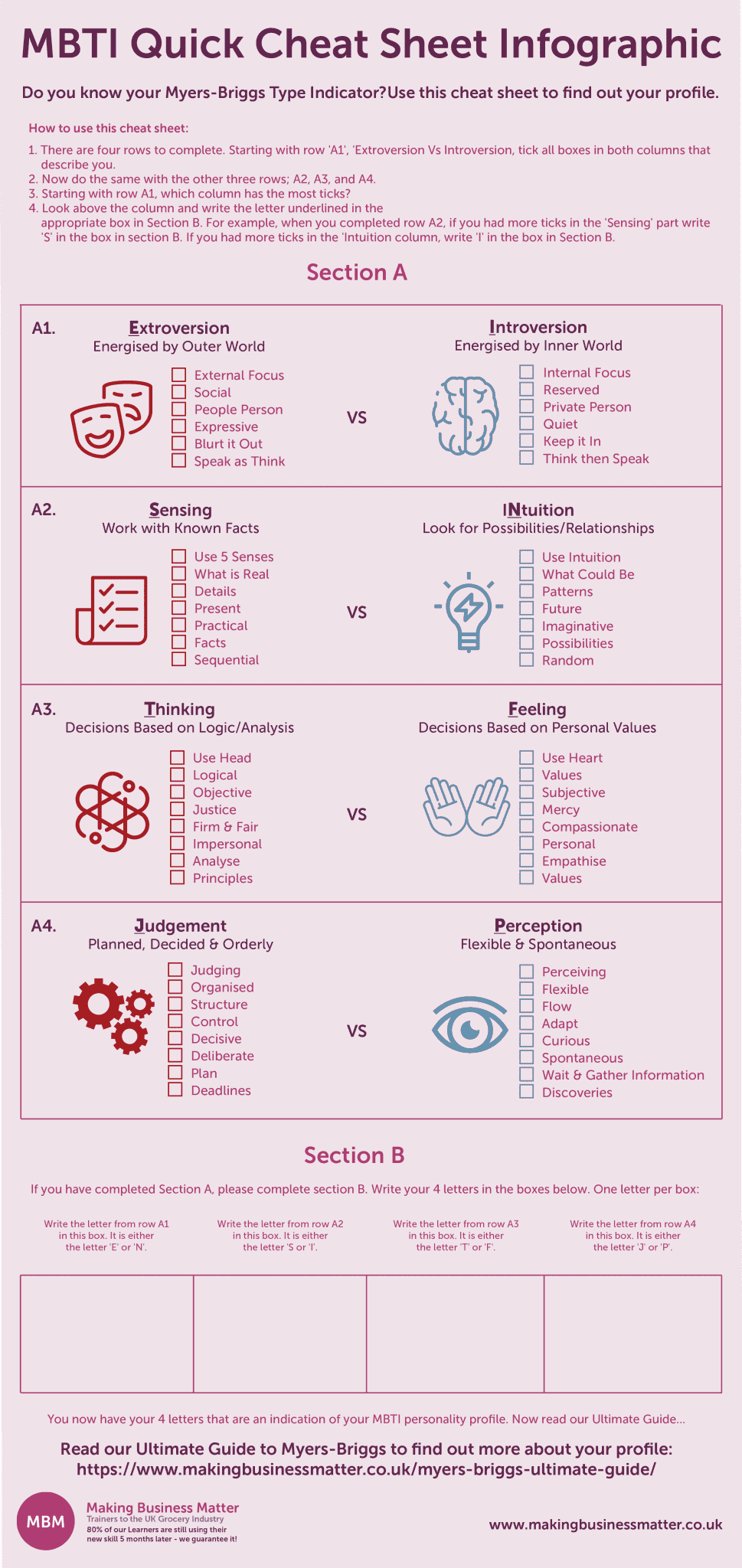
#2- DiSC Behavioral Assessment
DiSC is a behaviour assessment tool based on the theory of psychologist William Moulton Marston. It explores four different behavioural traits: dominance, inducement, submission, and compliance. All in all, it helps aid the discussion of people’s behavioural differences.
#3- The Belbin Team Inventory
Also called the Belbin Self-Perception Inventory, Belbin Team Role Inventory, BSPI or BTRI. It is a behavioural test devised by Meredith Belbin to measure preference for nine different team roles: plant, resource investigator, coordinator, shaper, monitor evaluator, teamworker, implementer, completer finisher and specialist.
#4- The GC Index
This profiling tool focuses on an individual’s preferred contribution style to a role or company. It uses the following categories: implementer, polisher, playmaker, strategist and game changer.
#5- Fundamental Interpersonal Relations Orientation
Introduced by William Schutz in 1958, this tool explains the interpersonal interactions of a group of people, based on how much interaction a person wants in the areas of inclusion, control and affection.
#6- Hogan Development Survey (HDS)
The HDS measures a person’s tendencies when under stress. Specifically, it can help show the ‘dark-side’ personality characteristics that can damage relationships and impinge upon long-term success.
#7- Occupational Personality Questionnaire (SHL’s OPQ)
Developed by Saville & Holdsworth Ltd, the OPQ is a personality test commonly used for recruitment. It measures 32 different personality traits as indicators of job-relevant behaviours.
#8- The Big Five Personality Traits
Also known as the five-factor model (FFM), the test consists of a series of statements, to which the subject answers how much they agree or disagree. Specifically, the test measures: openness, conscientiousness, extroversion, agreeableness, and neuroticism. These allow personal insight into how they will likely react in different situations.
#9- Personality and Preference Inventory (PAPI)
Originally designed by Dr Max Kostick, PAPI is a personality measure designed to elicit behaviours and preferences which are relevant to the workplace.
#10- Management Styles Inventory (MSI)
This is a self-scored tool that evaluates the effect on co-worker potential of an individual’s style of management. It explores the manager’s assumptions and priorities about the relationship between concerns for performance and concerns for people.
#11- CTPI-100 (The Central Test Personality Inventory)
A personality-based test is used primarily for managerial and executive-level candidates to show personality traits and behavioural competencies.
#12- 16pf (Sixteen Personality Factor Questionnaire)
This is used to show an individual’s dominant personality traits. Specifically, it explores 16 factors: warmth, reasoning, emotional stability, dominance, liveliness, rule-consciousness, social boldness, sensitivity, vigilance, abstractedness, privateness, apprehensiveness, openness to change, self-reliance, perfectionism, and tension.
#13- Thomas Kilmann Conflict Mode Instrument (TKI)
Helps measure how a person behaves when presented with a conflict situation. It analyses the dimensions of assertiveness and cooperativeness. We use this tool for Executive Coaching to help the coachee find and assess their conflict resolution skills.

11) HBDI vs Other Psychometric Testing Tools
As noted above, there are many psychometric profiling tools. They span from understanding the part you play in a team (Belbin), to how you react in conflict (TKI), to Myers-Briggs (MBTI), which helps us understand how we perceive the world and make decisions.
Our preference is Herrmann Brain Dominance Instrument because it is easy to grasp, whilst being able to offer useful insights to learners so they can become more comfortable with how they prefer to think.
The following White Paper looks at Herrmann Brain Dominance profiling and other assessments and how they can work together.

What are the Benefits of Using this Whole Brain Thinking Preference Model?
In our opinion, after working with these profiles for over the past 20 years the answer we have come to is, ‘Tolerance and Appreciation’. In essence, by understanding that people think differently you can start to ‘tolerate’ why they ask the questions they do. After tolerance comes appreciation because you then start to want to use their thinking diversity to enhance your own.
Most of us assume we are seeing the world the way it really is”.
– Ned Herrmann
For example, it is easy for the yellow quadrant to see the green quadrant, logical, robot-like, and reserved, as ‘detailed monkeys’. The appreciation comes when the yellows struggle to plan and a green can easily answer the how.
Model Validation
A number of validation studies have been carried out on HBDI over the last 10 years. Of these, including Berkeley, California, and the University of Texas, all have proven positive. Also, experts in the field consider this to be rare.
How Do We at MBM Use the Profiles for Our Clients?
We use Herrmann Drain Dominance Profiling for Executive Coaching, Team Building, and for some clients, to help every learner as they progress through their training.
We find that it helps us to coach more effectively because we understand the person better and, in turn, helps the coachee understand themselves better. Consequently, understanding the model provides a platform to give better feedback, in turn, improving communication and leadership skills.
For Team Building we find that Herrmann Brain Analysis helps employee engagement and supports the learner and the team to meet 3 of the 7 essential qualities of the Teamwork competency framework. For instance, (E) Trustworthy relationships, (F) Excellent communication, and (G) Feeding back to each other.
‘Whole Brain Learning’ enables the Learner to:
- Know why they prefer to understand facts that support the learnings (blue quadrant), or
- Learn better by understanding metaphors (yellow quadrant), or
- See why they need to create an action plan to carry out learnings (green quadrant), or
- Why they learn better through physical activities where they can touch and feel the learnings (red quadrant).
Herrmann Brain Dominance Instrument Training / HBDI Profiling / Training
Our Herrmann Brain Dominance Instrument ® / HBDI training helps each person to understand themselves, their colleagues, and everyone else better. Furthermore, you will be able to sell to the ‘whole buyer’ and influence better. This is because you will learn how to ‘talk in the other person’s language’, and appreciate their unique strengths.
So contact us can to find out how we can help you to achieve more. Our qualified Herrmann Brain Dominance Instrument/HBDI Training practitioners are from your industry and can provide training on any one of our products, from Category Management and GSCOP to Time Management and Influencing Skills, using our unique Sticky Learning methods.
12) Further Reading and Resources
TEDx Talk Tryon – Ann asks the question, “Do you manage your brain or does it manage you?” To reach your potential and use your brain to the full, you need to understand how it works. And, thus, what you can do to better use it.
Ann Herrmann at TEDx video, ‘Think like your future depends on it‘.
Ann Herrmann at TEDx video, ‘One thing to know about your brain that will change your life‘.
#1- in This 4-minute Video, Ned Herrmann Talks About His Model:
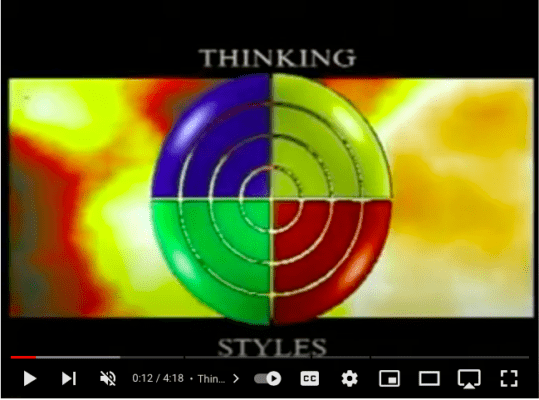
#2- Glossary
Read our Herrmann Whole Brain Thinking Glossary for a complete definition and A-Z of key terms. Additionally, feel free to take a look at all of our Soft Skills glossaries.
#3- Read our Blog
Take a look at our award-winning blog and its content on tips and benefits of using the Herrmann Brain Dominance Instrument.
Articles from Our Blog:
- Ways of thinking
- 6 thinking hats
- Black box thinking
#4- Watch Our Videos
Click below to see our YouTube channel and playlist with more tips on how to use the Herrmann Brain Dominance Instrument in the workplace:
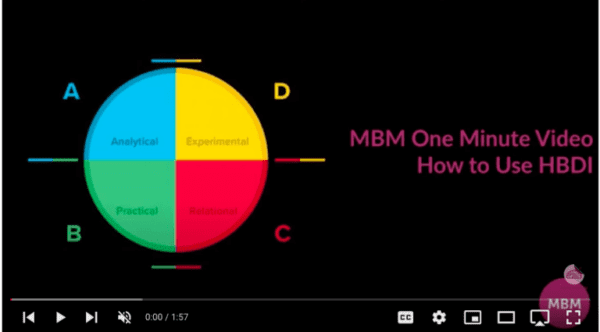
#5- Contact Us
Feel free to get in touch to find out how one of our qualified Herrmann Brain Dominance Instrument practitioners can help you or for more information on Herrmann Brain Analysis Profiling or HBDI Training Course. Simply visit here to contact us or email us at helpme@makingbusinessmatter.co.uk, and we will be happy to get back to you.


